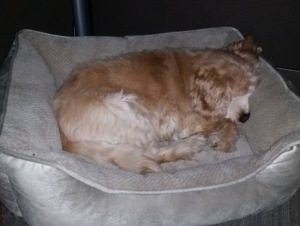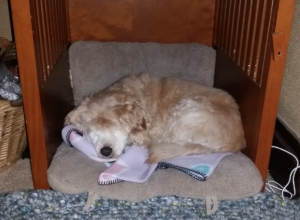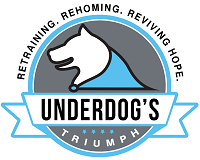Two of my good friends recently had their first baby (yay!). In addition to this little ball of adorable, they also have a few fluffy four-legged kids too. Now if two dogs, a cat and newborn sounds like a handful, their dogs, Violet and Prim, are also both special needs dogs. Both dogs are blind. To help decrease a bit of stress (and hopefully increase sleep) I’ve been watching Prim for two weeks now.
Prim was originally rescued from Missouri. While playing at the park a couple watched a car drive up, set little Prim on the ground and drive away. When the soon-to-be-rescuer got up to little Prim, the could see both of her eyes were completely destroyed. One was severely infected and the other was barely even connected anymore, plus she had a severe case of mange (a skin disease) which had made her lose most of her hair. The rescuer immediately scooped her up and took her to a local rescue. In order to save her life, Prim suddenly lost both her eyes and became blind.
Much like people, each dog handles disabilities different. Violet, their other blind adoption, is like a bull in a china shop. She doesn’t let her disability slow her down in the least. She knows all the key things blind dogs need to know: “step-up”/”step-down” (for navigating stairs), “careful” (for avoiding obstacles), how to give into lead pressure (to be guided via gentle pressure on the leash) and a few bonus behaviors like sit and shake. When at the dog park, she takes off after whatever smell hits her first and will wander for hours chasing scents.

Prim is different. Prim is more cautious. She freezes when she is put into a new place. And it takes here a good week or so to have the courage to explore a new area. She startles easily and has difficulty navigating around. She resists giving into any sort of lead pressure and thus has been unable to be walked. After a follow up vet appointment to help treat the mange, my friends and the vets also determined she’s mostly deaf too.
So what can we do for this adorable fluff?

In our last blog, we talked about enrichment and a few things you can do to make sure your dog/s are getting the stimulation and activity they need too. But what about little Prim? She’s lost lost two key senses: sight and hearing. Sounds like it’s time to get creative!
First, we need to focus on key sense Prim has that does work. Smell is the strongest sense a dog has. It’s somewhere between 10,000 and 100,000 times better than ours, which is statistic I can’t even begin to fathom. Taste also is closely tied to smell and as Prim munches down her dog food with as much vigor as a small fluff can, I can tell you that sense works very well too. 🙂
At work, I started taking a single USA made <<chicken strips>> and tearing it into the smallest pieces I possibly can. I’m talking like 1/3 of a dime in size here. And then I sprinkle them all over the floor. Believe it or not, Prim tracks down Every Single One. And it takes her about 20-30 minutes to consume what was originally a two bite chicken strip. Her tail wags like crazy the entire time. We’ve taken a simple boring two second activity, and turned it into a brain engaging, stimulating quest for chicken bits!
The second thing we can do is change her environment to make it more accommodating to her disability. While Prim was visiting I set her up with a little den in the living room. I put a uniquely textured rug (the only one of its kind in the house) in front of it and every single time I brought her into the house from somewhere I would place her here in the same exactly orientation. This serves two purposes, it allows her to identify where she is at, and marks her “entrance” to her little cave. The den also provides protection on three sides so she can feel safe & secure inside it. I also put a small diffuser above the crate with some lavender scent. This way, she knows the strong smell of lavender = her house.

The last thing we started working on was beginning preparations for a walk. In the last few days she’s started to explore the house and sometimes ends up in different places when it was time for dinner. I’d prep her food and set it above her crate then head off to go find Prim. I’d put my hands under her front arm pits (where a harness would rest) and gently encourage her to walk forward. When she did, she gets lots of high pitch praise (the one thing she can sorta here) and some good butt scratches. When we, finally, made it back to her doggie den, she’d be jackpotted with an entire bowl of delicious dinner!
The one major thing I did struggle with was how to wake Prim up. She’s a VERY heavy sleeper and not even high pitch sounds would wake her from her snoring slumber. I tried tapping on the ground, even stomping heavily as I would walk up to her but even that would only sometimes wake her up. And oftentimes she’d show stress signals at being startled awake, like a lip lick. Finally as I laid on the ground outside her den wracking my brain… Prim just woke up, tail thumping against the back of the crate. I was super confused. Can you guess what I did?
I breathed on her. And again, her noses KNOWS it was me and woke her up gradually without any stress signals. Yay!
All in all, having Prim visit with me for two weeks was a delight. It challenged my dog trainer mind to think outside the box to help meet her needs. It encouraged me to slow down and let her think, as with her limited senses it takes her a few extra seconds to understand what I was asking her to do. Special needs dogs are just as enriching to our own lives as able-bodied dogs, and I know this little fluff has definitely buried her way into my heart!
